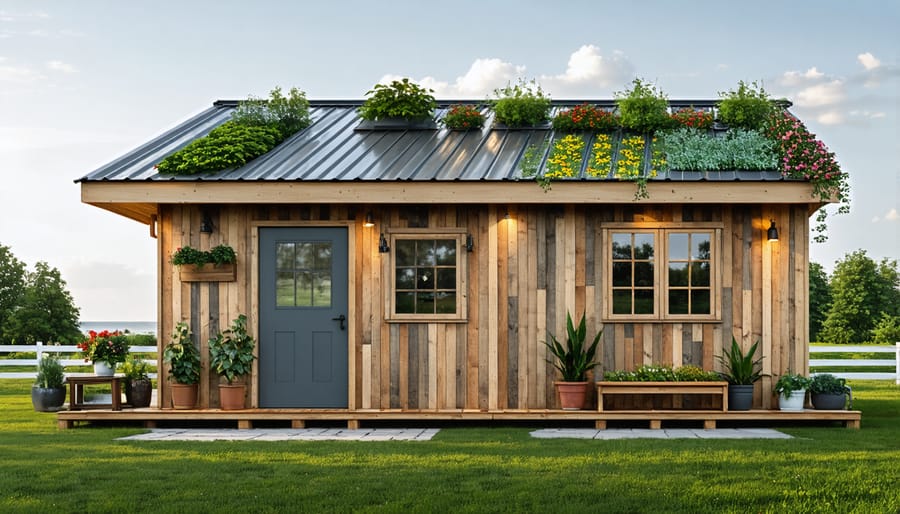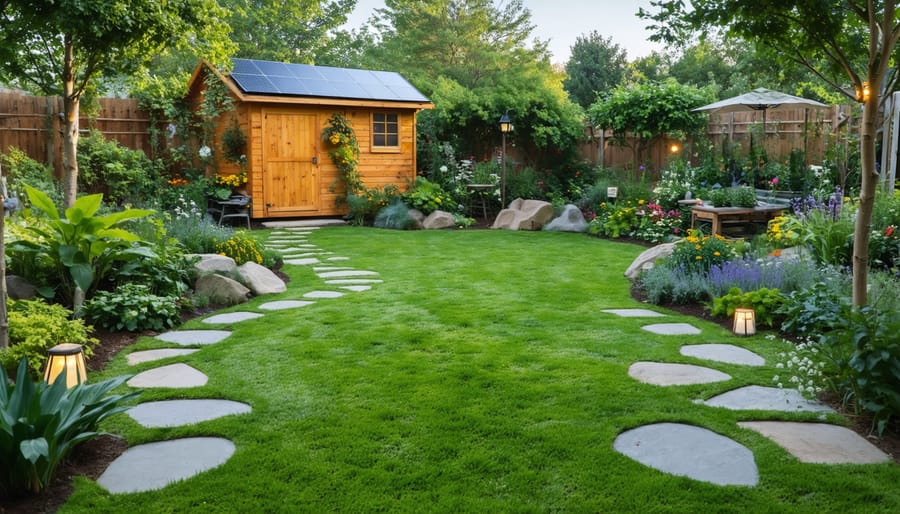Transform your backyard into a vibrant, sustainable ecosystem by replacing traditional lawns with native plant gardens that require minimal water and maintenance. Install rainwater harvesting systems connected to your eco-friendly shed conversion to create a self-sustaining irrigation network. Establish dedicated composting zones that turn yard waste into rich soil, reducing landfill impact while nourishing your garden naturally. Design permeable pathways using recycled materials to manage stormwater runoff while creating functional outdoor spaces. Integrate solar-powered lighting along garden paths and around seating areas to extend outdoor enjoyment into evening hours without increasing energy consumption. This thoughtful approach to yard design not only reduces environmental impact but also creates a resilient, low-maintenance outdoor space that enhances your property’s value while supporting local wildlife.
Smart Material Choices for Sustainable Shed Conversion

Reclaimed and Recycled Materials
Transform your shed project into an eco-friendly masterpiece by incorporating reclaimed and recycled materials. Start by exploring local salvage yards, construction sites (with permission), and online marketplaces for pre-loved treasures. Reclaimed wood from old barns or pallets can create stunning wall panels and shelving units, while vintage windows add character and natural light.
Consider using recycled metal roofing sheets, which not only reduce landfill waste but also provide excellent weather protection. Repurposed hardware like door handles, hinges, and hooks from architectural salvage stores add unique charm while keeping these items out of landfills.
For flooring, explore options like recycled rubber tiles made from old tires or composite decking created from reclaimed plastic and wood fibers. These materials are durable and require minimal maintenance. Don’t overlook creative possibilities like using old bicycle wheels as wall-mounted storage or converting wine bottles into light fixtures.
Remember to clean and treat all reclaimed materials properly before installation to ensure longevity and safety. Many homeowners report significant cost savings while achieving distinctive, environmentally conscious results with recycled materials.
Sustainable Building Materials
When choosing materials for your sustainable yard structures, opt for eco-friendly alternatives that minimize environmental impact while maintaining durability and aesthetic appeal. Bamboo stands out as a rapidly renewable resource, reaching maturity in just 3-5 years, making it an excellent choice for fencing and decorative elements. Its natural resistance to pests and moisture makes it particularly suitable for outdoor applications.
Sustainably harvested wood, certified by organizations like FSC (Forest Stewardship Council), ensures your building materials come from responsibly managed forests. Cedar and redwood are naturally resistant to decay and insects, reducing the need for chemical treatments while providing beautiful, long-lasting structures.
Recycled composite materials offer another eco-conscious option, combining reclaimed wood fibers with recycled plastics. These materials require minimal maintenance, resist weather damage, and help divert waste from landfills. For foundations and pathways, consider permeable pavers made from recycled materials or locally sourced natural stone.
Look for materials with high recycled content percentages and those manufactured within a reasonable distance to reduce transportation emissions. Many suppliers now offer reclaimed materials like vintage brick and repurposed timber, adding character while reducing environmental impact.
Energy-Efficient Design Elements
Natural Lighting Solutions
Harnessing natural light is a key element in creating a sustainable yard space, and it starts with thoughtful window placement. Strategic positioning of windows can dramatically reduce your reliance on artificial lighting while creating a more pleasant environment. Consider installing shed windows on east and west-facing walls to maximize daylight hours. Skylights are another excellent option, offering up to 30% more natural light than vertical windows and helping to maintain comfortable temperatures year-round.
When planning window placement, consider the sun’s path throughout different seasons. South-facing windows capture maximum winter sunlight while providing shade in summer months when the sun is higher. For optimal results, incorporate light-reflecting surfaces inside your structure and use light-colored materials that bounce natural light throughout the space.
Remember to use double-pane or energy-efficient glass options to maintain temperature control while letting in natural light. Adding adjustable window coverings or awnings can help manage light and heat during peak sun hours, ensuring your space remains comfortable and energy-efficient throughout the year.
Ventilation and Climate Control
Proper ventilation is key to maintaining a comfortable and healthy environment in your sustainable yard space. Natural ventilation strategies can help regulate temperature without relying on energy-intensive systems. Consider installing operable windows or vents positioned to catch prevailing breezes, creating a natural flow of air through your space.
Passive cooling techniques work wonders in reducing heat buildup. Strategic placement of shade trees or climbing plants around your yard can provide natural cooling, while light-colored surfaces reflect sunlight and minimize heat absorption. Installing a green roof or living wall not only adds insulation but also helps regulate temperature naturally.
For spaces that need additional cooling, consider solar-powered fans or vents that kick in during peak heat hours. These energy-efficient solutions can be particularly effective when combined with proper insulation and reflective materials. A well-planned combination of cross-ventilation, thermal mass materials, and natural shading can create a comfortable microclimate that requires minimal energy input while maintaining ideal conditions throughout the seasons.
Water Conservation Features
Rainwater Harvesting Systems
Harvesting rainwater is one of the smartest ways to make your yard more sustainable while reducing your water bills. Start with a basic setup by connecting your roof’s downspouts to rain barrels or larger storage tanks. These collection systems can store hundreds of gallons of free water for your garden, lawn, and indoor plants.
Choose food-grade plastic or metal containers with secure lids to prevent mosquito breeding and debris accumulation. Install an overflow valve and first-flush diverter to manage excess water and filter out initial roof runoff. Position your barrels on level, stable platforms to ensure proper water pressure and prevent tipping.
For maximum efficiency, consider installing a drip irrigation system connected to your rainwater storage. This setup delivers water directly to plant roots, reducing waste through evaporation. During dry spells, you’ll appreciate having this sustainable water source for your yard’s needs while conserving precious municipal water supplies.

Gray Water Integration
Gray water recycling is one of the smartest ways to maintain a sustainable yard while conserving precious water resources. By redirecting water from your sinks, showers, and washing machines to your garden, you can significantly reduce your outdoor water consumption. Setting up a basic gray water system can be as simple as installing a diverter valve on your washing machine’s discharge pipe, allowing you to direct the water either to your garden or the sewer system as needed.
When implementing a gray water system, use plant-friendly, biodegradable soaps and detergents to ensure your vegetation stays healthy. Consider creating a mulch basin around plants to help filter the water and prevent direct contact with edible portions of plants. Install simple irrigation tubes or drip lines to distribute gray water effectively throughout your garden beds.
Remember to check local regulations regarding gray water usage, as requirements vary by location. Most systems can be installed as a DIY project, though complex setups may require professional assistance.
Green Space Integration
Living Roofs and Walls
Living roofs and vertical gardens are game-changing additions that can transform your yard into a sustainable oasis. These green installations not only enhance your property’s visual appeal but also provide excellent insulation and support local biodiversity. Much like a sustainable greenhouse conversion, living roofs and walls create valuable growing space without consuming additional ground area.
To install a living roof, start with a waterproof membrane and root barrier, followed by a drainage layer and lightweight growing medium. Choose drought-resistant plants like sedums, herbs, and native wildflowers that require minimal maintenance. For vertical gardens, install a framework of panels or pockets that can support soil and plants while allowing proper irrigation.
Regular maintenance includes seasonal inspections of drainage systems, trimming overgrowth, and monitoring plant health. Water-efficient irrigation systems, such as drip lines or self-watering designs, help maintain optimal moisture levels while conserving water. These living installations can reduce energy costs by providing natural insulation, manage stormwater runoff, and create habitats for beneficial insects and birds.
For best results, consult with local experts to ensure your structure can support the additional weight and to select plants suited to your climate zone.

Native Plant Integration
Incorporating native plants around your shed creates a harmonious connection between your storage space and the local ecosystem. These indigenous species are perfectly adapted to your region’s climate, requiring less water and maintenance while providing essential habitat for local wildlife. Consider creating a border of native wildflowers, grasses, or shrubs that naturally thrive in your area.
Start by researching plants native to your region through local nurseries or gardening centers. Choose a mix of heights and blooming seasons to maintain visual interest throughout the year. Low-growing groundcovers can soften the transition between your shed and the surrounding landscape, while taller plants can help your shed blend naturally into the environment.
Popular native options often include butterfly weed, black-eyed susans, and native ferns for shade areas. These plants not only create an attractive setting but also support local pollinators and birds. Remember to group plants with similar water needs together and maintain adequate spacing to allow for growth.
For maximum sustainability, consider collecting rainwater from your shed’s roof to irrigate these plants, creating a self-sustaining mini ecosystem in your yard. This approach reduces water consumption while creating a beautiful, low-maintenance landscape that enhances your property’s natural character.
Transforming your yard into a sustainable space through thoughtful shed conversion is more than just a trend – it’s a meaningful step toward environmental stewardship and practical living. By implementing eco-friendly materials, efficient storage solutions, and green design principles, you’re not only creating a functional space but also contributing to a healthier planet. The benefits are clear: reduced energy consumption, lower maintenance costs, improved property value, and a smaller carbon footprint.
Remember that sustainability doesn’t mean sacrificing style or functionality. Your converted shed can serve as both a practical storage solution and an inspiring example of green living. Whether you choose to install solar panels, incorporate recycled materials, or add a living roof, each sustainable choice makes a positive impact on your local ecosystem.
Take the first step today by evaluating your current shed space and identifying areas for sustainable improvements. Start small if needed – even minor changes like adding natural lighting or installing rain barrels can make a significant difference. Your sustainable shed project will not only enhance your property but also inspire others in your community to embrace eco-friendly solutions for their outdoor spaces.





Leave a Reply